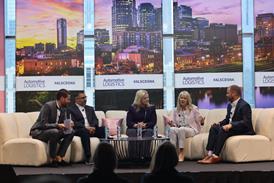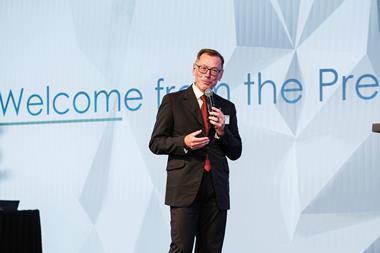With a new plant set to open this summer and expansion plans for existing facilities, Ford Mexico could double its output in the next few years, as imports continue to rise. Automotive Logistics finds out how the OEM plans to strengthen its supply chain and infrastructure to cope
Vehicle logistics remains a top concern for the management at carmakers producing and expanding in Mexico. At Ford Mexico, president and chief executive officer Gabriel López has plenty to keep him awake at night.
Like others, Ford faces constraints in Mexico’s vehicle-handling ports, most notably the country’s largest, Veracruz. Rail delays, especially in the central Bajío region of the country, where so much new vehicle capacity is being added, can lead to higher incidences of damage and theft, and delay shipments to customers in the US. Meanwhile, the surprisingly brisk Mexican sales market, which has been growing quickly over the past two years, has created shortages of car carriers and drivers, especially during seasonal peaks.
“We’re growing at a frantic pace and we need to see the right investments to match demand,” says López.
Such challenges are mostly par for the course in Mexico, where carmakers cannot avoid the country’s major ports or rail routes. And with Ford planning its third assembly plant in Mexico, a compact vehicle factory set to open by 2018 in San Luis Potosi in the northern part of the Bajío, López and his team are unlikely to be in for much relief.
Ford Mexico’s logistics team has nevertheless been successful in both managing through such constraints and implementing successful alternatives, including the use of a new west-coast port for exports and a new inbound pattern for fast-growing imports. Meanwhile, with the greenfield plant in San Luis Potosi about to start construction this summer, there is a clear opportunity to design yard and distribution processes that will support Ford’s expected growth in production and exports.
Planning rail from the start The San Luis Potosi plant should help Ford retain a high share of the fast-growing Mexican automotive production and export market. Last year, the OEM produced nearly 435,000 units (a slight decline on 2014) at its existing plants in Hermosillo, in the north-west, and Cuautitlán, north of Mexico City.
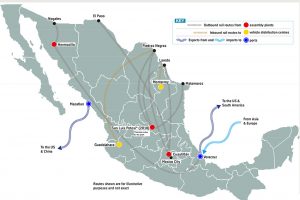
Of that total, around 413,000 were shipped abroad, including 392,000 to the US and Canada. Production and exports are expected to be at similar levels or slightly lower this year, notably as demand in the US remains tepid for the sedans and compact cars that Ford Mexico builds, while some key export markets, like Brazil, continue to see large declines.
However, with the new plant and as yet unconfirmed expansion in its existing facilities, Ford could see its Mexican output double over the coming years (see Ford Mexico part 1 for more on the company’s complete supply chain in Mexico).
While that will bring capacity issues, the carmaker continues to benefit from good rail infrastructure at its plants, with plans to make San Luis Potosi even more efficient. There are rail sidings directly at Ford’s Hermosillo and Cuautitlán facilities, as there will be at San Luis Potosi. Rafael López, director of material planning and logistics for Ford Mexico, points out that while the carmaker will have dedicated rail services from the new plant, Kansas City Southern de Mexico and Ferromex, the country’s two class one railways, both have connections nearby.
For Gabriel López, having rail access and multiple options right from the start was essential for the plant. He points to carmakers that have opened plants elsewhere, particularly around the Bajío, as well as to Kia in Monterrey further north, where projects to extend or expand rail access have been delayed, resulting in costly trucking operations. “Rail access was critical to deciding where to locate the plant,” he says.
Ford already uses a diverse set of rail routes from its Mexican plants, including a relatively short journey from Hermosillo through the border at Nogales, while Cuautitlán uses three routes through El Paso, Piedras Negra and Laredo. San Luis Potosi will also offer similar options, as well as a crossing further east through Matamoros to Brownsville, Texas, where a new rail bridge was recently completed.
The chance to go westThough rail is Ford Mexico’s dominant mode for export, it also has a dynamic shipping network for exports and imports. Its biggest port is Veracruz, which is part of a shipping loop Ford uses that circles South America and calls at the ports of Jacksonville, Florida and Baltimore, Maryland.
 “We’re growing at a frantic pace and we need to see the right investments to match demand… [San Luis Potosi’s] rail access was critical to deciding where to locate the plant” - Gabriel López, Ford Mexico
“We’re growing at a frantic pace and we need to see the right investments to match demand… [San Luis Potosi’s] rail access was critical to deciding where to locate the plant” - Gabriel López, Ford Mexico
Up until recently, Ford hadn’t used ocean transport to export from the west coast. Last year, however, it introduced the Pacific coast port of Mazatlan, where it has shipped the Lincoln MKZ from Hermosillo to the port of Portland, Oregon, to combine with other exports to China.
Starting in June, it started shipping directly to China from Mazatlan, which will allow faster shipping times as well as transport and inventory savings.
“We will get some savings in cost, customs clearance and a reduction in transport time by going direct to China,” says Gabriel López.
Ford is also planning to export to the US west coast for domestic distribution as well, though this is still being developed.
Mazatlan, which has only recently restarted handling vehicles, is further north than some of the other more common locations on the west coast, including Lázaro Cárdenas, Acapulco and Manzanillo, which makes it a better option notably for Hermosillo, which is in the north-west. The port has recently benefitted from a highway connecting it to inland Mexico, which Ford also uses to serve dealers in the Pacific area from its distribution centre in Monterrey.
Ford is currently moving vehicles from Hermosillo to Mazatlan by road, but it plans to switch to rail.
Gabriel López adds that using Mazatlan to the US isn’t necessarily about a lack of rail capacity from Mexico so much as it is an effort to introduce competition. “There is already some arbitration between the cost of railway and sea,” he says. “We could ship 100% by rail. It is not so much about the capacity, but because we are now getting better deals by moving by sea for some routes.”
The main flow of Ford’s ocean exports, however, moves through Veracruz, where López admits that there are capacity concerns. And while Mazatlan has proved an interesting option, possibilities at other ports remain limited – not necessarily because of a lack of shipping routes, but for a lack of inland connections. For example, the Gulf coast port of Tuxpan, north of Veracruz, could be an interesting alternative to it, but lacks an adequate rail connection. Even so, Ford has not yet ruled out the new location.
“We will study shipping vehicles there by truck since Tuxpan is the closest port to Mexico City,” says Rafael López.
Other ports have been vying for volume from Ford and other manufacturers, including the port of Guaymas, which is also in the state of Sonora. The governor of the state had indicated that she would encourage Ford to use the facility. However, López says Ford studied Guaymas and decided that Mazatlan was a better option.
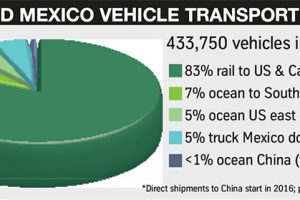 Ford Mexico vehicle transport – click to enlarge
Ford Mexico vehicle transport – click to enlargeImports on the riseWhile the main focus of automotive investment and attention in Mexico has been understandably on production and exports, a somewhat surprising development over the past two years has been the surge in domestic sales and especially vehicle imports. Light vehicle sales grew 19% in 2015 to 1.35m units and have risen a further 16.8% in the first five months of this year, according to AMIA, the Mexican automotive association. Ford Mexico’s sales grew 10% in 2015 to surpass 87,500 units and are up a further 4.8% so far this year.
The company’s domestic distribution moves through a network of distribution yards at major “centres of gravity”, according to Gabriel López, including those at or near its plants in Hermosillo and Cuautitlán, at the port of Veracruz, as well as in Guadalajara and Monterrey.
These yards hold Mexican-built stock, as well as ocean imports or vehicles from the US and Canada that arrive via rail imports. According to Rafael López, the new plant yard in San Luis Potosi will also be able to hold stock for domestic distribution in Mexico.
The Mexican market has been particularly hungry for vehicle imports. Last year, these rose to 717,500 units, up from 600,000 units in 2014, and they have increased another 21% so far this year. The strongest growth here has been by sea, notably from Asian countries including India, Thailand, Japan and South Korea, whose share is now around 45% of all imports to Mexico.
Unlike in the US, small and compact car sales are on the up in Mexico. With local production capacity so focused on US exports, many OEMs have increasingly imported such vehicles from markets like India, including Volkswagen, Hyundai, GM and Ford.
This rise has led to further changes to Ford’s shipping network. Its imports from India, for example, used to come via the Pacific to the west coast port of Lázaro Cárdenas. However, with the spike in volume, Ford has changed, together with other OEMs, to using a route that comes via the Suez Canal and over the Atlantic to Veracruz. “This route is large enough to justify a route with higher frequency. We are now getting around one-and-a-half sailings per month, on average,” says Gabriel López.
 Port of Veracruz: Gabriel López says there are capacity concerns here but other ports lack inland connections
Port of Veracruz: Gabriel López says there are capacity concerns here but other ports lack inland connectionsAlthough Veracruz has its space constraints, the combination of exports and imports in the port also allows for the possibility of more return transport services to and from the port.
However, Ford is not afraid to be mercurial about the trade routes. Rafael López says the company would switch back to Lázaro Cárdenas for imports should a better deal come along. “Today, the better offer is at Veracruz for us,” he says.
On a global stage Ford’s trading network may see further changes in future. In selecting San Luis Potosi, Joe Hinrichs, president of the Americas for Ford, points to Mexico’s free-trade agreements, which remove or reduce duties with around 45 countries, as a reason Ford could increase exports beyond North America. “The trade agreements Mexico has with several countries provide many opportunities for export growth,” says Hinrichs.
Currently, Ford Mexico exports to a number of countries in Latin America, especially the Fiesta, as well as to Asia, including Lincoln exports to China (although until recently, most of these went to the US first). The numbers beyond North America have fallen this year amidst the drop in Brazil and in Chinese demand for imports.
However, depending on the models that Ford selects for San Luis Potosi and its other plants over the coming model cycles, exports beyond North America could rise, says Gabriel López.
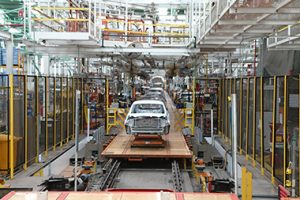 Ford Mexico’s exports to ‘non-traditional’ markets are predicted to increase
Ford Mexico’s exports to ‘non-traditional’ markets are predicted to increaseWhile plans are as yet unconfirmed, union and media sources have reported that Ford will move the Focus and C-Max sedans to Mexico from a factory near Detroit that is being retooled for SUVs, while Fusion production could also be concentrated in Mexico (it is currently co-located in Flat Rock, Michigan and Hermosillo). There has, furthermore, been discussion of a potential plug-in hybrid or electric vehicle that Ford could build in Mexico.
Ford imports from around the world may also rise further in Mexico. For several years it has been rumoured that the next Fiesta model will be built and exported from Thailand, suggesting more Asian imports to Mexico for Ford, as well as the potential for a new model to come to Cuautitlán.
Gabriel López has said nothing concrete about the next round of models in Mexico, but he does predict that exports from all three Mexican assembly plants will increase to “non-traditional markets”. And he expects a rise in global exchanges across the company.
“The next round of models will dictate where they will be exported, but we will see more interchange across regions as complexity increases and demand for alternative powertrains grows in North America and elsewhere,” he says.
See Ford Mexico part 1 for more on the company’s complete supply chain in Mexico.
“The next round of models will dictate where they will be exported, but we will see more interchange across regions as complexity increases and demand for alternative powertrains grows in North America and elsewhere” - Gabriel López, Ford Mexico




